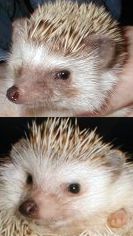|
Hedgehog
Facts:
The
very first hedgehog show was held in Tacoma Washington, USA, on
October 22, 1995. Close to 100 shows across the United
States and Canada have been held since. |
|
|
Hedgehog color genetics have come a long way
in just 10 years. We currently
recognize 92 colors in two distinct group classifications – White-Bellied and
Algerian. To understand why there
are 2 color groups is to understand the genesis of the domestic hedgehog.
The domestic hedgehog that we have in North
America, South America, parts of Europe and Japan is the result of the crossing
of two distinctly different species of African Hedgehog - the White-Bellied
(Atelerix albiventris) and the Algerian. (Atelerix algirus)
 While the two species were a compatible mix, blending the physical
characteristics of each into the pet hedgehog of today, the colors proved
incompatible and never did successfully blend. (The Apricot was the only color
to succeed in coming out of this cross, being a true mutation created when the
cinnamon genes of the two species collided) As a result, we now have two
distinct and separate color groups within the color classification system of the
domestic hedgehog. The two species colors cannot mix either. At no time will you
ever see a <GM>, <CL>, or any other such inter-species mixing of
color gene sets. There is a defined and impassable barrier between the color
groups. This is not, however, true of the physical characteristics. You
may still see an Algerian-colored hedgehog with White-Bellied physical features
and vice versa.
While the two species were a compatible mix, blending the physical
characteristics of each into the pet hedgehog of today, the colors proved
incompatible and never did successfully blend. (The Apricot was the only color
to succeed in coming out of this cross, being a true mutation created when the
cinnamon genes of the two species collided) As a result, we now have two
distinct and separate color groups within the color classification system of the
domestic hedgehog. The two species colors cannot mix either. At no time will you
ever see a <GM>, <CL>, or any other such inter-species mixing of
color gene sets. There is a defined and impassable barrier between the color
groups. This is not, however, true of the physical characteristics. You
may still see an Algerian-colored hedgehog with White-Bellied physical features
and vice versa.
In spite of the obvious incompatibility
between the color groups, they do mirror one another rather nicely. All
variations of color that exist in White-Bellied's also hold true for Algerians.
There are 15 dominant colors, running the gamut between Black and Apricot, as
well as the complete set of recessives, dilutes, etc. Once you understand the
genetic pattern for one species color, you likewise have it for the other.
To learn more about hedgehog colors, review
the Color Guide or contact the IHA for more
information
|

